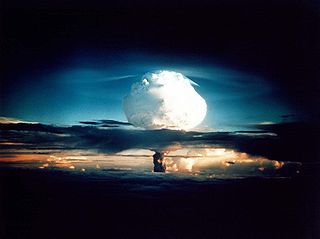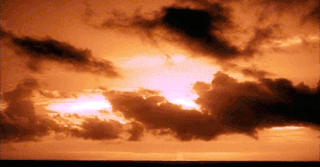
The Tsar Bomba, also known by the alphanumerical designation "AN602", was a thermonuclear aerial bomb, and the most powerful nuclear weapon ever created and tested. The Soviet physicist Andrei Sakharov oversaw the project at Arzamas-16, while the main work of design was by Sakharov, Viktor Adamsky, Yuri Babayev, Yuri Smirnov, and Yuri Trutnev. The project was ordered by Nikita Khrushchev in July 1961 as part of the Soviet resumption of nuclear testing after the Test Ban Moratorium, with the detonation timed to coincide with the 22nd Congress of the Communist Party of the Soviet Union.

Nuclear weapon designs are physical, chemical, and engineering arrangements that cause the physics package of a nuclear weapon to detonate. There are three existing basic design types:

A mushroom cloud is a distinctive mushroom-shaped flammagenitus cloud of debris, smoke, and usually condensed water vapor resulting from a large explosion. The effect is most commonly associated with a nuclear explosion, but any sufficiently energetic detonation or deflagration will produce the same effect. They can be caused by powerful conventional weapons, like thermobaric weapons such as the ATBIP and GBU-43/B MOAB. Some volcanic eruptions and impact events can produce natural mushroom clouds.

Operation Castle was a United States series of high-yield (high-energy) nuclear tests by Joint Task Force 7 (JTF-7) at Bikini Atoll beginning in March 1954. It followed Operation Upshot–Knothole and preceded Operation Teapot.

Operation Greenhouse was the fifth American nuclear test series, the second conducted in 1951 and the first to test principles that would lead to developing thermonuclear weapons. Conducted at the new Pacific Proving Ground, on islands of the Enewetak Atoll, it mounted the devices on large steel towers to simulate air bursts. This series of nuclear weapons tests was preceded by Operation Ranger and succeeded by Operation Buster-Jangle.

Operation Upshot–Knothole was a series of eleven nuclear test shots conducted in 1953 at the Nevada Test Site. It followed Operation Ivy and preceded Operation Castle.

Ivy King was the largest pure-fission nuclear bomb ever tested by the United States. The bomb was tested during the Truman administration as part of Operation Ivy. This series of tests involved the development of very powerful nuclear weapons in response to the nuclear weapons program of the Soviet Union.

Castle Bravo was the first in a series of high-yield thermonuclear weapon design tests conducted by the United States at Bikini Atoll, Marshall Islands, as part of Operation Castle. Detonated on March 1, 1954, the device remains the most powerful nuclear device ever detonated by the United States and the first lithium deuteride-fueled thermonuclear weapon tested using the Teller-Ulam design. Castle Bravo's yield was 15 megatonnes of TNT (63 PJ), 2.5 times the predicted 6 megatonnes of TNT (25 PJ), due to unforeseen additional reactions involving lithium-7, which led to radioactive contamination in the surrounding area.

Ivy Mike was the codename given to the first full-scale test of a thermonuclear device, in which part of the explosive yield comes from nuclear fusion. Ivy Mike was detonated on November 1, 1952, by the United States on the island of Elugelab in Enewetak Atoll, in the now independent island nation of the Marshall Islands, as part of Operation Ivy. It was the first full test of the Teller–Ulam design, a staged fusion device.

Elugelab, or Elugelap, was an island, part of the Enewetak Atoll in the Marshall Islands. It was destroyed by the world's first true hydrogen bomb test on 1 November 1952, a test which was codenamed shot "Mike" of Operation Ivy. Prior to being destroyed, the island was described as "just another small naked island of the atoll".
RDS-37 was the Soviet Union's first two-stage hydrogen bomb, first tested on 22 November 1955. The weapon had a nominal yield of approximately 3 megatons. It was scaled down to 1.6 megatons for the live test.

Castle Yankee was the code name given to one of the tests in the Operation Castle series of American tests of thermonuclear bombs. It was originally intended as a test of a TX-16/EC-16 Jughead bomb, but the design became obsolete after the Castle Bravo test was successful. The test device was replaced with a TX-24/EC-24 Runt II bomb which was detonated on May 5, 1954, at Bikini Atoll. It released energy equivalent to 13.5 megatons of TNT, the second-largest yield ever in a U.S. fusion weapon test.

Castle Romeo was the code name given to one of the tests in the Operation Castle series of U.S. nuclear tests. It was the first test of the TX-17 thermonuclear weapon, the first deployed thermonuclear bomb.

A thermonuclear weapon, fusion weapon or hydrogen bomb (H bomb) is a second-generation nuclear weapon design. Its greater sophistication affords it vastly greater destructive power than first-generation nuclear bombs, a more compact size, a lower mass, or a combination of these benefits. Characteristics of nuclear fusion reactions make possible the use of non-fissile depleted uranium as the weapon's main fuel, thus allowing more efficient use of scarce fissile material such as uranium-235 or plutonium-239. The first full-scale thermonuclear test was carried out by the United States in 1952; the concept has since been employed by most of the world's nuclear powers in the design of their weapons.

The Teller–Ulam design is a technical concept behind modern thermonuclear weapons, also known as hydrogen bombs. The design – the details of which are military secrets and known to only a handful of major nations – is believed to be used in virtually all modern nuclear weapons that make up the arsenals of the major nuclear powers.

The explosive yield of a nuclear weapon is the amount of energy released such as blast, thermal, and nuclear radiation, when that particular nuclear weapon is detonated, usually expressed as a TNT equivalent (the standardized equivalent mass of trinitrotoluene which, if detonated, would produce the same energy discharge), either in kilotonnes (kt—thousands of tonnes of TNT), in megatonnes (Mt—millions of tonnes of TNT), or sometimes in terajoules (TJ). An explosive yield of one terajoule is equal to 0.239 kilotonnes of TNT. Because the accuracy of any measurement of the energy released by TNT has always been problematic, the conventional definition is that one kilotonne of TNT is held simply to be equivalent to 1012 calories.

A nuclear explosion is an explosion that occurs as a result of the rapid release of energy from a high-speed nuclear reaction. The driving reaction may be nuclear fission or nuclear fusion or a multi-stage cascading combination of the two, though to date all fusion-based weapons have used a fission device to initiate fusion, and a pure fusion weapon remains a hypothetical device. Nuclear explosions are used in nuclear weapons and nuclear testing.

Operation Redwing was a United States series of 17 nuclear test detonations from May to July 1956. They were conducted at Bikini and Enewetak atolls by Joint Task Force 7 (JTF7). The entire operation followed Project 56 and preceded Project 57. The primary intention was to test new, second-generation thermonuclear weapons. Also tested were fission devices intended to be used as primaries for thermonuclear weapons, and small tactical weapons for air defense. Redwing demonstrated the first United States airdrop of a deliverable hydrogen bomb during test Cherokee. Because the yields for many tests at Operation Castle in 1954 were dramatically higher than predictions, Redwing was conducted using an "energy budget": There were limits to the total amount of energy released, and the amount of fission yield was also strictly controlled. Fission, primarily "fast" fission of the natural uranium tamper surrounding the fusion capsule, greatly increases the yield of thermonuclear devices, and constitutes the great majority of the fallout, as nuclear fusion is a relatively clean reaction.

A fizzle occurs when the detonation of a device for creating a nuclear explosion grossly fails to meet its expected yield. The bombs still detonate, but the detonation is much less than anticipated. The cause(s) for the failure can be linked to improper design, poor construction, or lack of expertise. All countries that have had a nuclear weapons testing program have experienced some fizzles. A fizzle can spread radioactive material throughout the surrounding area, involve a partial fission reaction of the fissile material, or both. For practical purposes, a fizzle can still have considerable explosive yield when compared to conventional weapons.
























